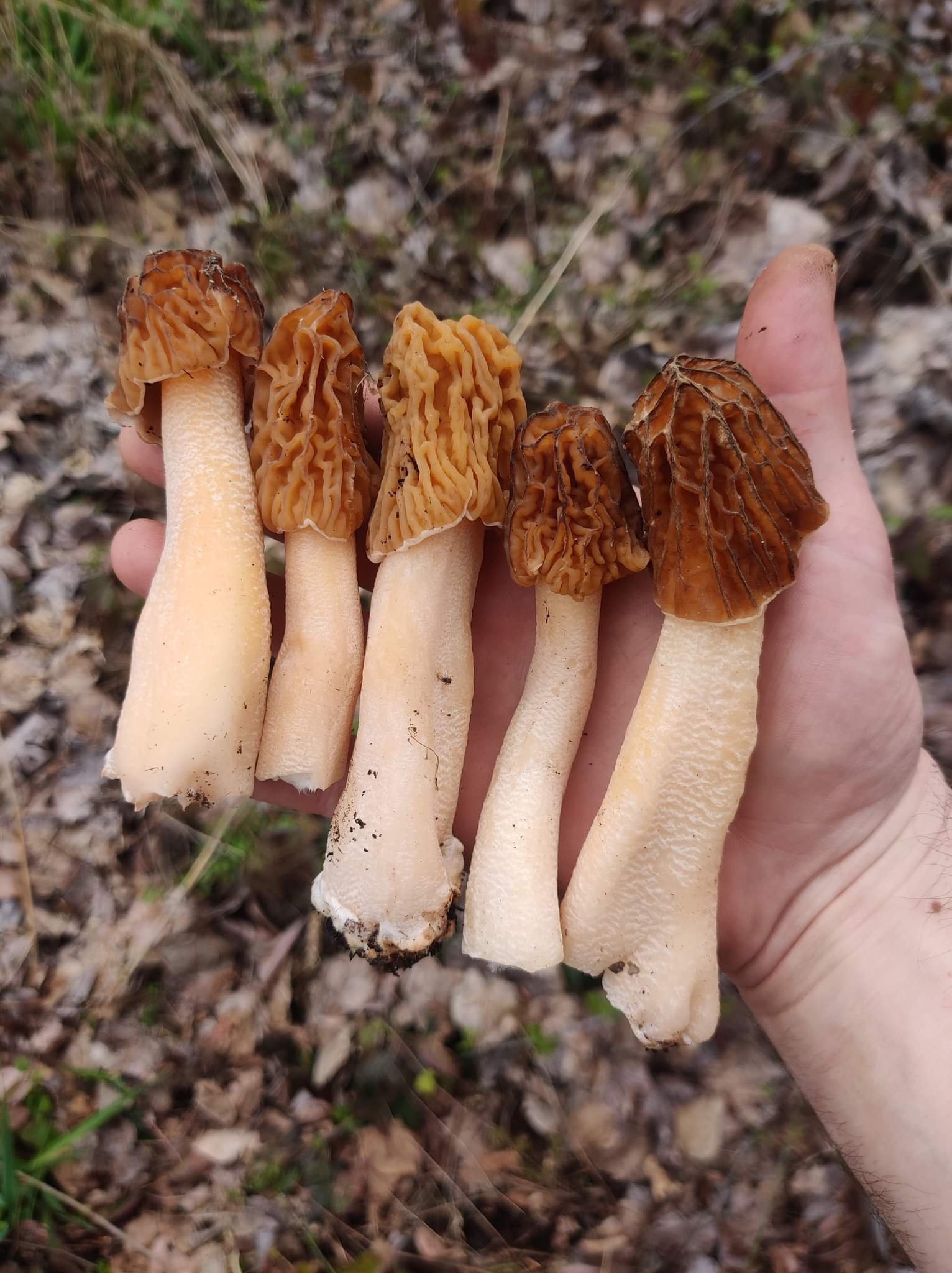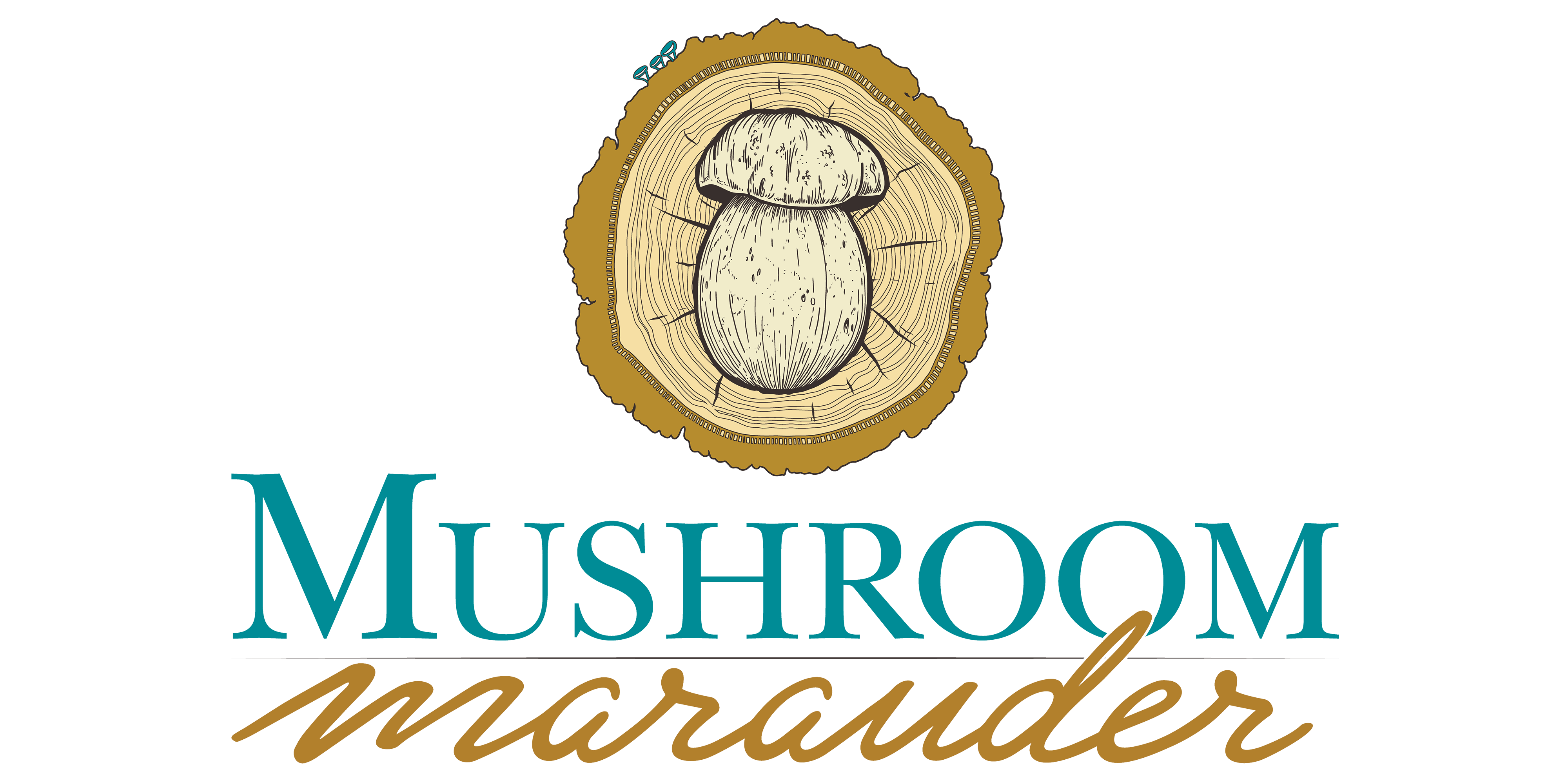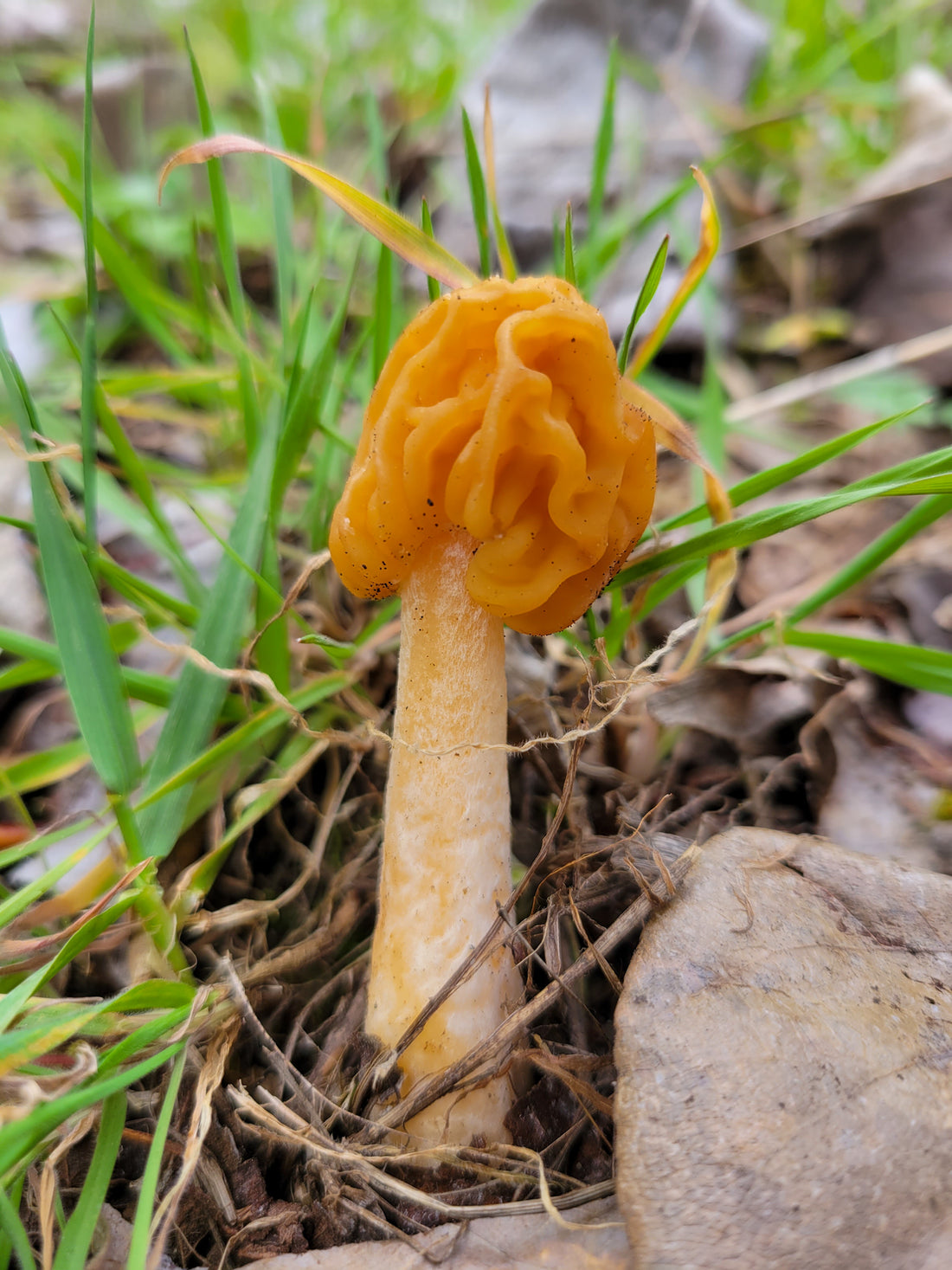Disclaimer: As much as it might feel like one at times, foraging and eating wild mushrooms is not a game. Before ingesting any mushroom, it must be identified as edible with 100% certainty by someone qualified to do so. On top of that: any mushroom that you haven't eaten before should be cooked well and eaten in very small quantities the first time, to be sure that the person eating them does not have an intolerance. BE SAFE OUT THERE.

Some impressive Verpa bohemica in hand, photo credit Susan Griswold
Hi there! Welcome to my little corner of the internet, where you get to nerd out about fungi to your heart's desire and nobody shall ever, ever judge you for it. You can stay here as long as you like! When we say “Early Morels”, we're talking about the genus Verpa, and in particular the species Verpa conica (AKA Smooth Thimble Cap) and Verpa bohemica (AKA Wrinkled Thimble Cap). If you're finding Early Morels, in all likelihood they will be one of these two species. Before we dive too far into the specifics about identifying Verpa (and how to find them!), we should cover why these delicious mushrooms are so undervalued!
To make a long story short, Verpa have a somewhat confusing edibility status. This confusion stems from a variety of causes, including: mistaken identity, being lumped in with more toxic fungi, the misnomer “false morel” being applied liberally across several genera, and the unverified but published musings of mycologists snowballing through a few mycophobic decades in the USA.
Recent publications by trusted mycologists, like Mushrooms of the Redwood Coast by Noah Siegel and Christian Shwarz, simply list V. conica and V. bohemica as “edible”. No caveats or warnings of any sort.
These mushrooms are widely eaten and sold commercially in other parts of the world. The vast, vast majority of people who speak out against them are US citizens with a lack of knowledge about mushrooms. Verpa species are no more toxic than any “true morel”, and should be treated as such. The subject of edibility is covered in detail in THIS wonderful article by Fungi Magazine. (You can also take any issues with the term “Early Morels” to the respected mycologists and editors over at Fungi Magazine, not my inbox please. 🥰)
However, since there’s still that outdated info floating around and keeping people from picking Verpa, we can use that misinformation to our advantage: it just means there are more of them out there for the rest of us that know better!
Combine all of this with the fact that Verpa are a fairly widespread species with a tendency to fruit prolifically in large areas of the the USA and beyond, and we end up with an annual Springtime treat that is relatively easy to obtain, but mostly ignored by other pickers! These statuesque, unique mushrooms can provide a wonderful warm-up to the “true” Morel season.
Now that we have all that out of the way, we can focus on how to find and identify these wonderful spring treats!

Map of Verpa conica distribution in North America, courtesy of MushroomObserver.org
Confidently Identifying Verpa
Let’s start by taking a look at the main difference between the two species of Verpa that we’ll be discussing today. If you didn’t catch it from their common names above (Wrinkled Thimble Cap vs. Smooth Thimble Cap) Verpa bohemica has a distinctly wrinkled or pitted cap, while Verpa conica will have a much smoother, rounded cap (although it may become *slightly* wrinkled with age or dry weather). Verpa conica will also generally be a bit smaller than V. bohemica in stature. Other than that, the two species are close enough to the naked eye that we don’t need to make many other distinctions between them. Let’s dig on in and by take a close look at the two visible sections of the Verpa fruiting body: the cap (or pileus), and the stem (or stipe, as you prefer).
Pileus (Cap):

Verpa Bohemica has a cap with deep wrinkles/ridges that can even appear as “pits” in older and larger specimens.
Verpas have a generally conical/cylindrical shaped brown cap that can grow up to 2.5” across and 4” tall! One of the distinct features that separate Verpa from similar species of Morels and Gyromitra is the attachment of the cap to the stem: The caps of Verpa attach only to the very top of the stipe. Imagine resting an oversized thimble on your fingertip, so that it only touches the tip of your finger. If your finger was the stem of the mushroom, the attachment point would be only where the fingertip touched the thimble. Another good analogy is that the cap hangs around the stipe like a lampshade. The flesh of Verpa caps is fairly brittle and flimsy. Given their singular attachment point, this flimsy flesh can lead to troops of capless Verpa late in the season! An animal brushing against a cap could easily knock it off, or the weight of the cap itself could even slide it down around the stipe. (See Photo) The flesh is of course weakened by age and seems to absorb a lot of water, so heavy rains cause a lot of potential damage.

Verpa bohemica, exhibiting a somewhat common species trait because of its weak flesh and singular cap attachment: the cap of the mushroom has broken and slid down around the stipe!

Verpa conica, with its smooth, round cap. Photo credit biolib.cz

A cross-section of Verpa bohemica. Note the cap attachment at the very top of the stipe, which has a single hollow chamber filled with a pithy/cobwebby substance. These are key identifiers for Verpa.
Stipe (Stem):
The stipes of Verpa are usually more or less equal in diameter, whitish, and their exterior is often covered in very small granules or scales. At maturity, stem size will range from .5”-1.5”+ in diameter, and 2.5”-8”+ in length. The flesh of Verpa stipes is brittle and breakable, although generally not quite as flimsy as the caps. The interior of Verpa stipes are one of their other distinct features: they are hollow, and usually filled with a white, pithy substance. This pith is as edible as the rest of the mushroom, and pretty much disappears when you cook it. The “cobweb” type material in the stipe *can* be absent in very young or aged specimens, but rarely will you find a Verpa stem that is entirely devoid of pith. Except for the pith inside, the stipes of Verpa are truly hollow. They are not chambered or layered, although they may naturally fold onto themselves depending on growth environment! Once you become familiar with the species, you’ll have no trouble identifying a Verpa just from the look and feel of the stipe, without needing to break it open.
Other Verpa Traits

Comparison diagram of 3 kinds of Morchellaceae. Credit: Patrick McRoberts.
We’ve covered the majority of the physical aspects of Verpa species, but let’s touch on just a few more points before we move on to the actual “how to find them” part of this little blog!
-
Odor: Fairly mild, earthy, reminiscent of Morchella.
-
Taste: Indistinct, but not unpleasant.
-
Ecology: Scattered or Single growth patterns, often growing near each other but very rarely truly attached.
-
Spore Print: Yellow
-
Season: Verpa season generally starts about a few weeks before other riparian morels, and also continues into morel season for about a month (weather and location depending).
-
Lookalikes: not many! Besides similar edible species of Morchella, the only thing you could really mix a Verpa up with would be Gyromitra, which are not nearly as fragile, very rarely have a single hollow chamber in their stipe, and don’t generally associate with the same trees or have an overlapping growth area. That being said: always be sure of what you’re eating. A 100% confident identification is required when eating any wild mushroom.
How To Find Verpa!
Now that we’ve covered how to identify Verpa, let’s get into how/where to find them. Here in the Pacific Northwest, our Verpa prefer the same kind of terrain that our Morchella americana inhabit: sandy soil near riverbeds. I can speak from personal experience and say that both the Columbia and Willamette rivers produce massive amounts of Verpa each year. Boggy areas with standing water, or ponds, will also often have Verpas growing around their edges. They’ll be found growing in leaf litter near aspens, cottonwoods and willows. Sometimes, this leaf litter prevents them from being seen until they are already past their prime, if they ever even break the surface!

Willow Tree

Cottonwood Tree

If your Cottonwood buds look like this, Verpas should be out, or out soon!!

Aspen Trees
-
Learn those 3 trees: aspens, cottonwoods and willows. If you don’t have a combination of sandy soil and at least one of those tree species, your chances of finding Verpa are basically nil.
-
Another great tip to finding Verpa is to watch for other foragers. Last year while out scouting for Morchella, I was led to a brand new patch of Verpa by the sound of excited voices shouting to each other! Keeping a respectful distance (hiding from them), I marked the spot for later and will be checking it this Spring!
-
I cover this next bit in detail in my 10 Morel Hunting Tips For Spring 2022 blog, (tip # 6) but the OnX Hunt App is an invaluable tool for foraging. In the event that you see terrain nearby that looks like it has good potential and aren’t sure who owns the land, you can simply open OnX and click the location of the land that you want to know the owner of. This way you can stay respectful, not trespass, and also see what lands nearby are public. Not to mention satellite views, topography, and you can even try to tell the tree species from that aerial view if you want! (If you already know what that tree species looks like from other locations this task is much easier)
-
Google Maps is also great way to see what trees are in an area! Go to Google Maps (a PC is best), zoom in to “Street View”, and just look on either side of the road. Trees like cottonwoods are pretty distinct, and easy to spot from your monitor instead of driving for hours on the chance they might be there. 😉 You can then check that location using your OnX Hunt App to see who owns it!

Screenshot demonstrating using Onx Hunt for land ownership knowledge (Those are also Cottonwood Trees)

Screenshot demonstrating locating Cottonwood trees near Portland using Street View on Google Maps

A beautiful collection of Verpa in hand, photo credit Eric Badeau

A cross-section of 4 equally edible members of Morchellaceae

Verpa stipes can get quite long, as compared to their caps!
-
Since Landscape Morels are some of the earliest to show, their season often heavily overlaps with when Verpas are growing! Check out my blog on How to Find Morel Mushrooms Without Leaving The City for some helpful tips for finding these urban treats!
-
Just like morels, get low and go slow. Especially early in the season, Verpa can hide under that leaf layer, but even if they’re not hiding: their yellowish-brown caps often camouflages against the leaves and woody debris in the background. Get low to the ground and look out across the distance, looking for irregular shapes as well as colors!
-
Also like morels, Verpa tend to grow in groups. Not necessarily right next to each other, and rarely touching: but it’s not uncommon to see 20+ in an area the size of a living room. As with so many mushrooms, it benefits the forager to stop and look closely once you have found one, to seek out any that may be camouflaged by the leaves, or even buried underneath them!

- Remember to rinse your Verpas well! Since they grow in sandy soil, they often get sands between the wrinkles in their caps! Do not soak them, they are too fragile for even a short soak!
-
Last But Not Least: don’t miss the chance to jazz up your foraging gear with one of her hilarious, adorable and even sexy Mushroom stickers!

Thank you so much for spending a few minutes here in my little corner of the internet. I truly hope you gained something of value here today, and that your next Verpa hunt goes just smashingly! Let me know in the comments how you did, or if there’s anything else you’d like to know about Verpas. As the co-owners of Mushroom Marauder, my wife Suzi and I would like to extend a sincere thank you for your support: you are quite literally turning our dream into a reality. If you did enjoy this content, or even if you hated it but just can’t resist yourself for some reason: please check out our Linktree to follow all our Social Media accounts like Instagram and Facebook. Again: thank you for your support and I hope you have a fantastic day! Mush love, fellow foragers.
~Adam McCrae

